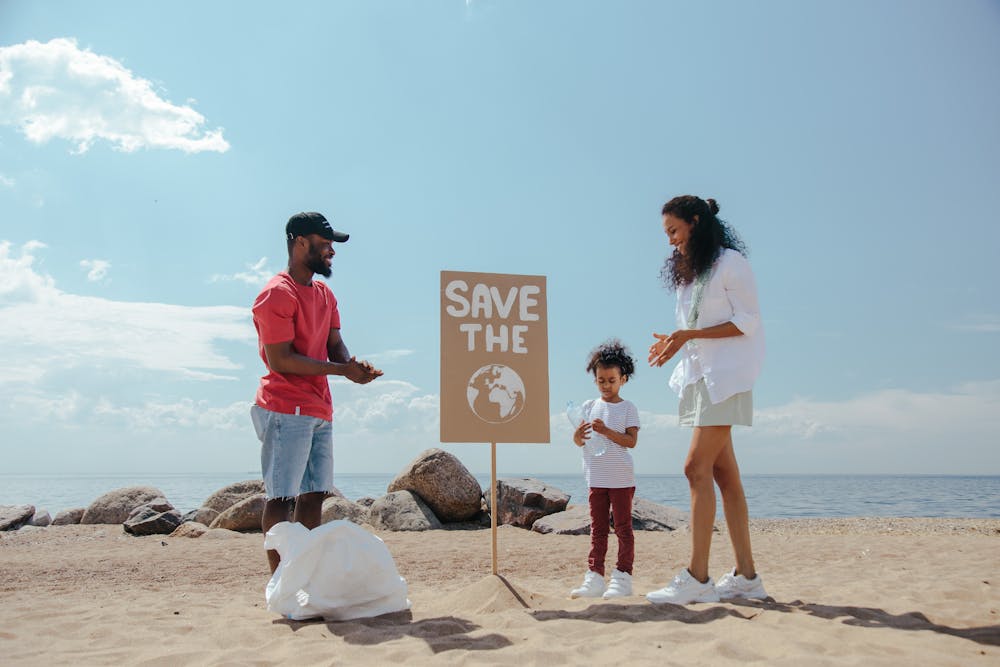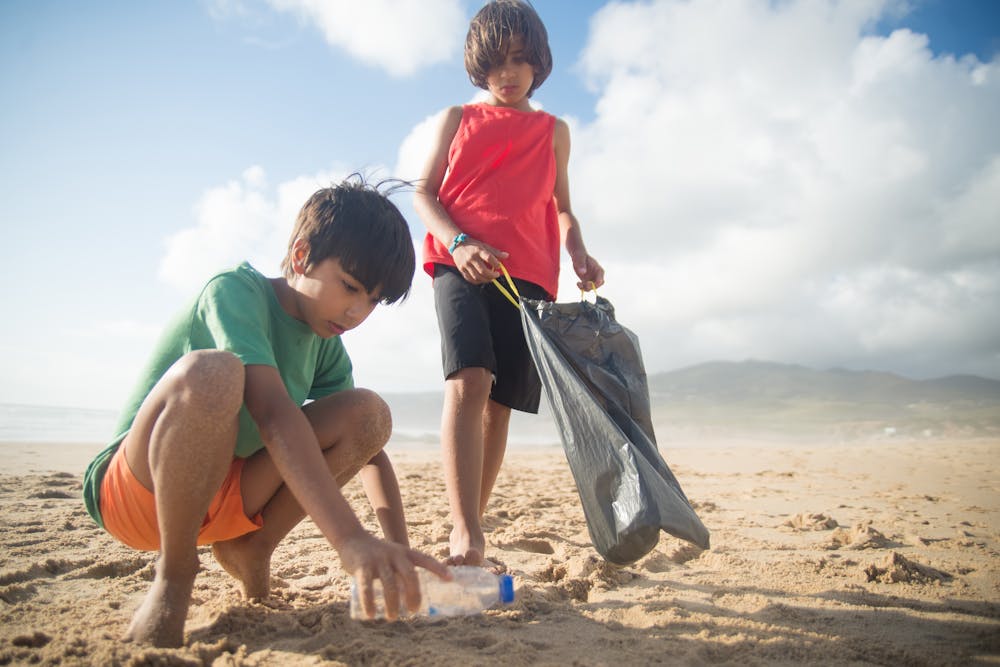Teaching kids eco-friendly habits isn’t as hard as it might sound. Children are naturally curious and love learning new things, so it’s just a matter of making green living fun and relatable. The easiest way to do this is by starting small. Don’t overwhelm them with complex concepts like “carbon footprints” or “sustainable sourcing” right away. Begin with simple, everyday tasks that they can do at home, like reusing shopping bags, reducing plastic use, or sorting rubbish for recycling. These small habits can grow into a more profound respect for the environment as they get older. Once these routines are part of their daily life, they’ll start making eco-friendly choices without thinking about it – and maybe even correct you when you forget to recycle that yoghurt pot!

Simple Habits To Start With
Teaching kids eco-friendly habits doesn’t need to be complicated. You can introduce a few everyday habits to help them become little green warriors.
Reuse, Reuse, Reuse
One of the easiest habits to start with is reusing items. Kids love to repurpose things, so make it a game. Shopping bags are a good place to begin. Show them how single-use plastic bags are a menace to the planet, but a sturdy reusable bag can be used over and over. Let them pick out their own reusable bags with fun designs. Challenge them to remember their bags the next time you’re at the supermarket. They’ll feel proud when they do, which turns into a positive learning moment.
Clothes and toys are another great area for teaching reuse. Rather than chucking out old toys, have them donate to a charity shop or swap with friends. It teaches them to be green, share, and be kind.
Cut Down on Plastic
Reducing plastic use is another simple yet impactful lesson. Explain to your kids that plastic often ends up in oceans, harming wildlife. You can make this real for them by showing videos or pictures of animals affected by plastic pollution. Then, involve them in small changes at home, like using refillable water bottles or switching to bar soap instead of bottled body wash.
Have them help you spot alternatives when shopping. This can turn into a scavenger hunt of sorts – “find the product with no plastic packaging!” You might be surprised by how keen they become on spotting greener choices.

Separate Your Rubbish
Rubbish sorting is the most hands-on way for kids to participate in eco-friendly living. Set up separate bins for recycling, compost, and general waste, and colour-code them for extra fun. Teach them what goes into each bin and explain how recycled materials can be turned into new products.
For younger kids, it’s like playing a sorting game. Older ones can handle more detail, like understanding how composting helps the soil. You can even make it a challenge – whoever sorts their waste correctly all week gets a treat! Soon, they’ll be so good at it that they might remind you when you slip up.
Making Green Learning Fun
Now that you’ve got some simple habits lined up, it’s time to think about how to teach these lessons most engagingly. Kids learn best through fun; the more exciting you make it, the more likely they will stick with it.
Games and Competitions
Turn eco-friendly activities into a game or contest. Kids love competition, especially when there’s a reward at the end. Have them compete to see who can collect the most recyclables weekly or use the least plastic during family meals. Even a simple “who can turn off the most lights” challenge can involve the whole family in reducing energy consumption.
Older kids, particularly teenagers, can access apps or games that track energy usage or recycling habits. They’re already glued to their phones—why not make them work for the planet? Several eco-conscious apps turn environmental responsibility into a game, complete with points and rewards.
Personal Example
Children are like sponges – they soak up everything they see. If you want your kids to be eco-friendly, you’ve got to lead by example. If they see you making green choices, they’ll naturally follow suit. That means talking about the importance of the environment and showing it through your actions. Avoid driving when possible, switch to eco-friendly products, and be consistent with your recycling habits. When they see it’s important to you, they’ll be more likely to adopt these habits themselves.
Reward Their Efforts
Everyone loves a reward, right? Kids, especially, thrive on positive reinforcement. Whether it’s a gold star, an extra 15 minutes of screen time, or a trip to the park, find something that motivates them. You can create an “eco-point” system where every green action earns them points towards a reward. It doesn’t need to be material – experiences like a special nature walk or a picnic with no waste are great incentives, too. Over time, the habits themselves will become rewarding enough.
Tailoring Lessons to Age
Kids at different ages learn differently. What works for your five-year-old might not cut it for your 15-year-old, and that’s perfectly fine. Here’s a breakdown of adapting your eco-lessons depending on the age group.
Small Children (Ages 3-8)
For the little ones, simplicity is key. They love stories, games, and visual learning. At this age, focus on fun, sensory experiences like planting trees, sorting recyclables, and reusing items for crafts.
Teaching them about nature can be magical – go on a bug hunt, plant flowers, or talk about the birds you see outside. Get them involved in eco-friendly chores like watering plants or feeding kitchen scraps to a compost bin. Even turning off lights when leaving a room can be presented as a small but mighty superpower!
Remember, they may not yet grasp the whole concept of climate change or endangered species. Keep the lessons simple and positive—talk about how their actions help the Earth stay happy and healthy.
Tweens (Ages 9-12)
Tweens are ready for more hands-on involvement. At this stage, you can start explaining why these habits matter. Have more in-depth conversations about recycling, conservation, and the impact of plastic. They’re old enough to grasp the bigger picture and can participate in more advanced eco-friendly projects like community clean-ups or starting a small vegetable garden.
This is a good age for letting them take ownership of a family recycling plan or teaching them to reduce food waste by planning meals. They’re proud of taking on responsibilities, and giving them eco-friendly tasks reinforces the habit.
Teenagers (Ages 13+)
Teenagers can sometimes be tricky – they might roll their eyes at your attempts to get them to care about the environment. But teens are also passionate and want to make a difference. Appeal to this desire by discussing the global issues behind eco-friendly living. Bring up things like climate change, pollution, and ethical consumerism. Encourage them to take part in school eco-clubs or green activism.
They might even want to go vegan or vegetarian, ditch fast fashion, or start a project in their school for zero-waste lunches. The key here is letting them lead. They’ll be all in if they feel like they’re making a real difference.
Wrapping Up
Teaching your kids eco-friendly habits is a marathon, not a sprint. Start small, make it fun, and model good behaviour yourself. By introducing these habits early on, you’re helping them become responsible citizens and creating a new generation of eco-conscious adults who’ll carry on the good fight. Plus, when your little one corrects you for using a plastic straw, you’ll know you’ve done your job well!